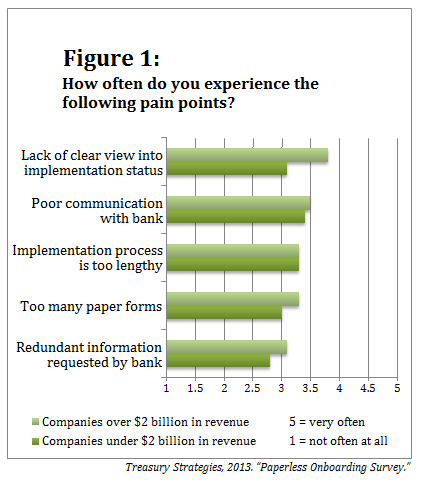To gain a better understanding of the complexities and inefficiencies inherent in modern “treasury onboarding,” Treasury Strategies recently undertook a survey, commissioned by WAUSAU Financial Systems, a vendor of solutions for payments and receivables processing. The survey gauged the opinions of both banks and corporate users of banking services about the process through which banks sell and then implement new services for corporate clients. Corporate treasurers may not be surprised to learn that the businesses outside the financial services sector see more problems with the process than do their banks.
Treasury Strategies asked the corporate respondents how frequently they face issues such as a lack of visibility into the implementation process, unnecessarily long or inefficient implementations, and poor communication with the bank. “All of those problems were rated above a 3 out of 5, with 5 meaning 'very often,'” says Chris Zegal, vice president of marketing at WAUSAU. “An issue rated 3 probably occurs fairly often.” The average frequency rating that large companies assigned to the problem of lacking a clear view into the implementation's status was 3.8, and these organizations experience communication problems at a frequency of 3.5 (see Figure 1). “Since all of these are rated above a 3, the companies probably have some sort of challenge in every implementation. It seems like problems are the norm rather than the exception,” Zegal adds.
Survey respondents who work for banks gave these issues considerably lower frequency ratings than did the corporate respondents. For example, large banks scored “customer is dissatisfied with communication” at 2.5, compared with the 3.5 that companies gave “poor communication with bank.” As Zegal interprets this result: “The banks know they have these challenges, but they don't think they happen as frequently as the corporations think they do.”

The survey also asked companies which banking services are most painful to implement. Lockbox services ranked first, but many respondents indicated that their organization has also struggled to get up to speed with online banking, Automated Clearing House (ACH) transactions, remote deposit, and wire transfers (see Figure 2). All except wholesale lockbox services are less painful for larger companies than for smaller businesses—presumably because larger organizations have more resources to devote to implementation.
“Companies want to go live with these services quickly and easily,” says Joe Pitzo, vice president, paperless enterprise solutions, for WAUSAU. “It should be painless. And what we see in this survey is that that isn't always the case.”

“The expectations of companies today are much like those of consumers,” Pitzo adds. “They want to be kept up to date throughout the entire process, from sales through delivery and training on new services. They get that type of notification on UPS and FedEx deliveries. Even with food deliveries you're kept up to date. And treasurers expect a similar response from their financial institutions when they're signing up for services.”
© 2025 ALM Global, LLC, All Rights Reserved. Request academic re-use from www.copyright.com. All other uses, submit a request to [email protected]. For more information visit Asset & Logo Licensing.




